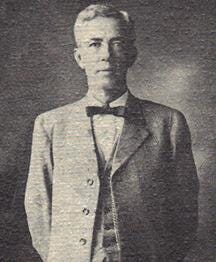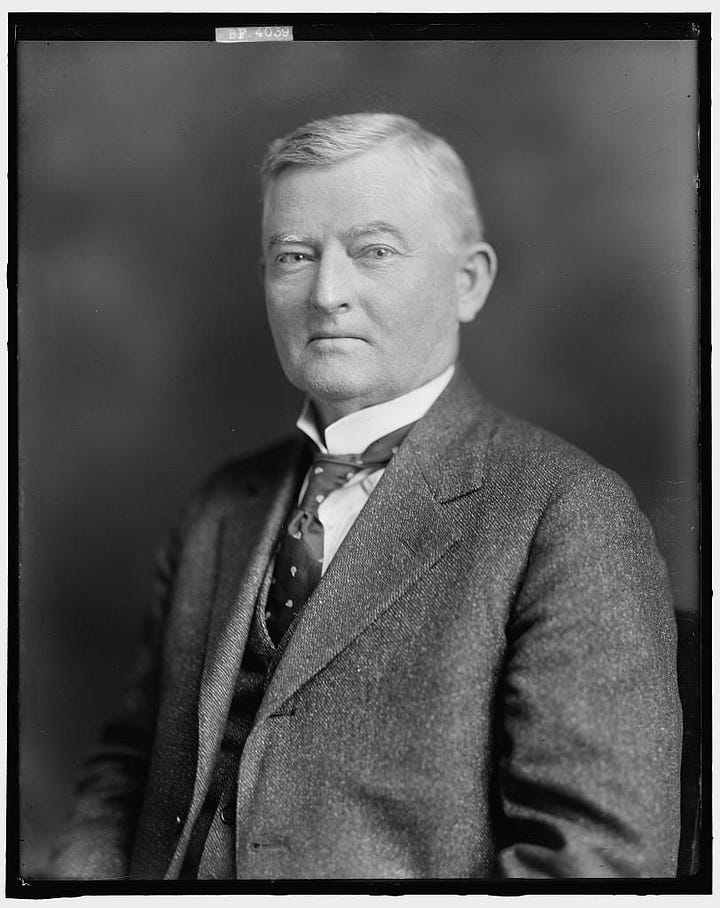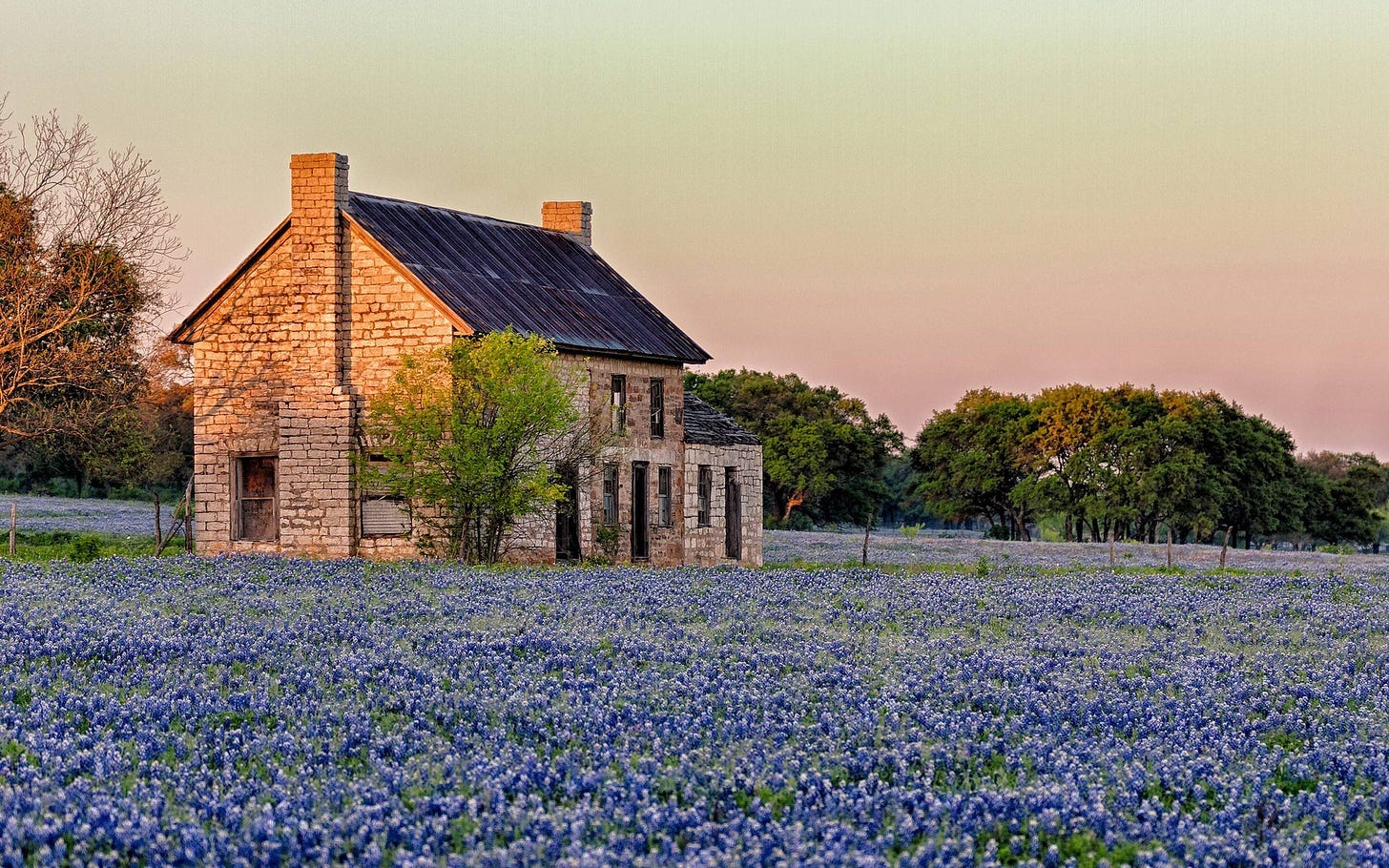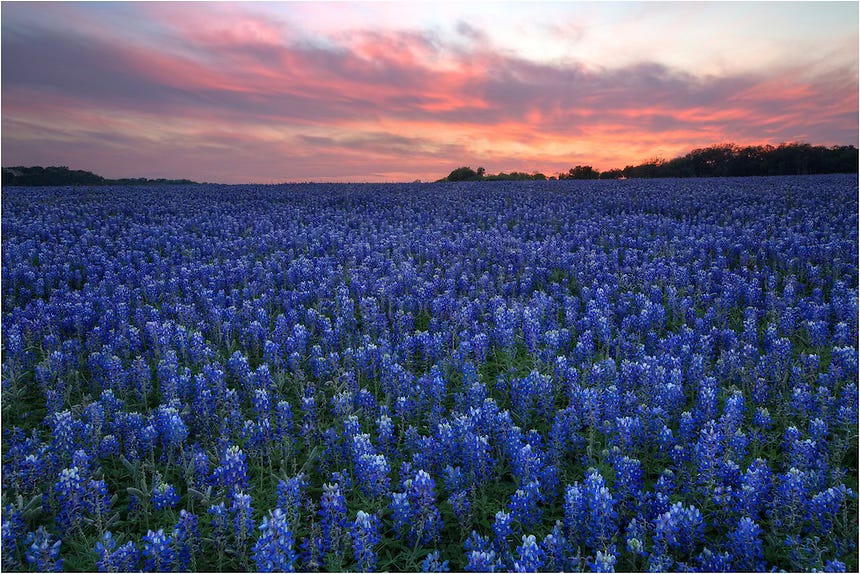Legends of the Bluebonnet
The evanescence of petal and leaf mingling into an aroma that is at once delicate and as tonic as heifer’s breath. –J. Frank Dobie
Y’allogy is 1836 percent pure bred, open range guide to the people, places, and past of the great Lone Star. We speak Texan here. Y’alloy is free of charge, but I’d be much obliged if you’d consider riding for the brand as a paid subscriber. (Annual subscribers of $50 receive, upon request, a special gift: an autographed copy of my literary western, Blood Touching Blood.)
Theodore Roosevelt wasn’t a Texan by birth. But he was a Texan at heart. In the spring of 1905, Roosevelt made a whistle stop tour of Texas. Large crowds of jubilant Texans greeted Roosevelt at every stop to listen to an American president and gawk at an American hero. On April 6, in Waco, Roosevelt told the gathered throng, “I believe in Texas with all my heart and soul.” Later that day, in Austin, a parade was held in Roosevelt’s honor. Thousands of schoolchildren lined the parade route, singing “America,” and showering Roosevelt with bluebonnets.
Little did Roosevelt know how grateful he should have been the state flower wasn’t the cotton boll or prickly pear—the other contenders for state flowerhood. Four years before his Texas visit, the legislature decided Texas needed an official flower. Representative John Green of Cuero proposed the bluebonnet—lupinus subcarnosus—and received support from the Colonial Dames of Texas. But since cotton was king in Texas, as the saying went, the cotton boll—“the white flower of commerce”—had the backing of the agricultural industry, making it a strong contender. John Nance Garner, future vice president of the United States, however, favored a plant that grew in abundance in the environs of his hometown Uvalde—the prickly pear cactus. He gave such an eloquent speech in defense of the prickly pear he forever became know as “Cactus Jack.”


The vote for naming the state flower was scheduled for March 7, 1901. It was anybody’s guess which way the vote would go. Fearing the bonnie blue flower would be defeated by two non-flowers the Dames went to the hills surrounding Austin and picked a mess of bluebonnets. They entered the House with a bouquet of flowers and a sweet fragrance filled the chamber. They also displayed Mode Walker’s oil painting, “Bluebonnets and Evening Primroses.” Their spectacle, according to one account, produced a “Deep silence [that] reigned for an instance,” swinging the vote in favor of the bluebonnet and sealing the defeat of the cotton boll and the prickly pear. Even Cactus Jack couldn’t resist the beauty and aroma of the little blue flower, voting in favor of Green’s proposal. “Then a deafening applause fairly shook the old walls.”
After passing the resolution naming lupinus subcarnosus the state flower, however, an uproar began. Bluebonnet aficionados questioned why the Texas bluebonnet—lupinus texensis—which produces a deep blue hue and covers the roadsides, fields, and hillsides of Central Texas wasn’t named the state flower. Unknown to Representative Green (and perhaps the Dames) there are six known bluebonnet species in Texas. The general consensus among bluebonnet lovers was: Leave it to a politician to screw up a state flower resolution. It took seventy years for the legislature to correct their mistake (sort of) by passing a new resolution including the Texas bluebonnet and “any other variety of bluebonnet not heretofore recorded,” such as the plains bluebonnet of the Panhandle and the tall bluebonnets of the Big Bend Region.
The beautiful blue flower has been known by other names. It’s been called the “wolf flower” in the false belief it robs the soil of necessary nutrients, just as a wolf robs a shepherd of his sheep. In reality, bluebonnets infuse the soil with needed nitrogen. The bluebonnet has also been called “buffalo clover.” This time in the false belief that buffalo graze on bluebonnets. They don’t, nor do cattle or horses. Only goats, who’ll eat just about anything, and sheep eat bluebonnets. Hispanics sometimes call bluebonnets “el conejo”—the rabbit, because the white-spotted blossoms resemble the scut of cottontails.
Representative Green might have selected the wrong species for the state flower, but he was right in choosing the bluebonnet in the first place. Its tie to Texas is rich in history and in lore. There are at least five legends that speak of the bluebonnet’s origin in Texas.
The Legend of the Aztec Maiden
Before Spain conquered Mexico an agonizing pestilence ravaged the land of the Aztecs. The prayers of the priest and the pleas of the people went unanswered by Tezcatlipoca. Then one day, he did. He demanded a living sacrifice of a sinless person to atone for the wickedness of the people—the cause of the pestilence. An Aztec virgin offered herself, to save her people. She was escorted to a hill-topped altar and placed upon it. Before the knife was plunged into her beating heart her blue headdress fell from her head and landed at the base of the altar. With the deed done, her blood ran down the altar and splotched her headdress. She was then taken up and buried, but her headdress remained atop the hill at the altar’s pedestal. The next morning, the hill and the grounds about were carpeted with flowers bearing the pattern and color of her headdress, each blue leaf was spotted white before it turned blood red—just as the purity of the Aztec maiden was offered to Tezcatlipoca as a blood sacrifice.
The Legend of the Spanish Missionaries
After Spain conquered Mexico Spanish missionaries established missions throughout Mexico, including the state of Coahuila y Tejas. The missionaries spread the gospel in an effort to save native souls and spread the seeds of a blue flower to beautify the native soil—seeds of flowers that grew on the hillsides outside Jerusalem. They planted these seeds within the walls of their mission gardens, but the little blue flower didn’t remain within the walls of their mission gardens. Just as the gospel spread across Mexico, so the flower spread across Mexico, covering the ground in a blanket of blue.
The Legend of the “Lady in Blue”
Nestled in a convent in Agreda, Spain María de Jesús prayed. A nun of the Franciscan order of Poor Clares, she was said to perform the miracle of bilocation—to physically appear in another place without leaving her convent’s cell. In July 1629 she appeared to a group of Jumanos Indians who lived in the Trans-Pecos region of Texas. After teaching them the sign of the cross, she instructed them to seek out the Franciscan missionaries in what is today Albuquerque, New Mexico. The padres there would teach them about Christ. When the Jumanos arrived at the mission, they told the padres of a visit by a beautiful young woman who wore a blue cloak over a brown and white habit. The padres were amazed. They had just received a letter from the archbishop of New Spain about María de Jesús. Two padres accompanied the Jumanos back to Texas and spoke with the tribe who told of a lady in blue visiting them on various occasions as a “light at sunset.” On the morning after her last visit, they told the padres, they woke to find their fields enveloped in a flower of deep blue.
The Legend of the Indian War
Long before Spaniards arrived on the shores of Mexico or rode ponies across the Rio Grande, native tribes had warred against each other—Apaches, Wichitas, Pueblos, Jumanos, Caddos, Atakapas, Karankawas, Coahuiltecans, Tonkawas, Kiowa, and Comanches. Some were driven from their native lands, others were absorbed into dominate tribes or killed outright. Warriors who died in battle, according to the tradition of many native tribes, were escorted to the “happy hunting-grounds.”* In the spirit world battles should cease. Warrior should not raise bow and arrow, spear and shield against warrior. But that was not always so. It was there, in the spirit world, where a battle raged. As warriors rode spirit horses across the sky, killing and being killed, blocks of blue sky fell to the earth and shattered into tiny pieces like blue pottery on the ground. In time, these blue seeds from the blue sky blossomed into bluebonnets.
The Legend of the Comanche Doll
Perhaps the best known and best loved legend of the bluebonnet comes from a story told among the Comanches. The Numunuu—“the people”—as the Comanches called themselves, had endured a great flood and suffered through a severe drought and a bone-chilling winter. Animal forage was short-supplied and animal life was short-lived. The People starved—and died. Disease ran rampant. Páháh was angry with the People and would not be appeased. Medicine men chanted and danced around fires. Warriors sliced their skin with skinning knives and wailed for relief. But Páháh remained silent. And silent he remained for days unending.
Then he spoke to the medicine men who spoke to the People: Páháh demanded a burnt offering of their most valuable possession. The ashes were then to be scattered to the four winds to atone for their selfishness.
A little girl sat in the darkness, just outside the ring of firelight where the warriors met in council, listening to the medicine men. She held her beloved doll to her chest, the one dressed in a soft deerskin robe, whose raven horsehair was braided and decorated with bright blue bird feathers—the bird that sings, “Jay! Jay!” To her mother and father, and all the other People, her doll was just a deer skinned plaything, but to her it was her most prized possession—and she knew what she must do.
Late that night, when all the People were asleep, she crept out of her tipi, clutching her doll close to her heart. She took a burning coal from the council fire and walked to a nearby hill where she collected sticks and built a fire. As he fed the flames with ever larger pieces of wood tears streamed her face. Flames leapt and licked the cool air. She held her doll skyward and asked Páháh to accept it as the sacrifice of the People’s most valuable possession. She then tossed her doll into the midst of the fire and watched through tear-wetted eyes as the flames consumed the deerskin robe, the horsehair braids, and the bright blue feathers.
She knelt by the dying fire. Now extinguished and cooled, she scooped a handful of ash and stood. She blew ash to the north wind. She blew ash to the south wind. She blew ash to the east wind. She blew ash to the west wind.
The next morning, when she came out of her tipi the hillside and the ground round about was overspread in beautiful blue flowers. When the People saw the blanket of blue they knew Páháh was no longer angry with them. The land became green and lush, and the little girl who sacrificed her most precious possession, the most selfless of all, was named One-Who-Dearly-Loves-Her-People.
✭ ✭ ✭
* This phrase first appeared in print in James Fenimore Cooper, The Pioneers, or The Sources of the Susquehanna: A Descriptive Tale, reprint (1823; New York: D. Appleton & Company, 1872), 183.
Randolph B. Campbell, Gone to Texas: A History of the Lone Star State (New York: Oxford University Press, 2003), 38–39.
Tomie DePaola, The Legend of the Bluebonnet: An Old Tale of Texas Retold and Illustrated (New York: G. P. Putnam’s Sons, 1983).
J. Frank Dobie, Tales of Old-Time Texas (Boston: Little Brown and Company, 1955), 141–46.
Elizabeth “Bessie” M. Reid, “An Indian Legend of the Blue Bonnet,” in J. Frank Dobie, ed., Legends of Texas, reprint (Corpus Christi: Copano Bay, 2024), 241–45.
Jan Reid, “Mood Indigo,” Texas Monthly, May 1991.
Elizabeth Silverthorne, Legends & Lore of Texas Wildflowers (College Station: Texas A&M University Press, 1996), 21–25.
✭ ✭ ✭
Support Y’allogy—
Much obliged, y’all.





Thanks for the sources!